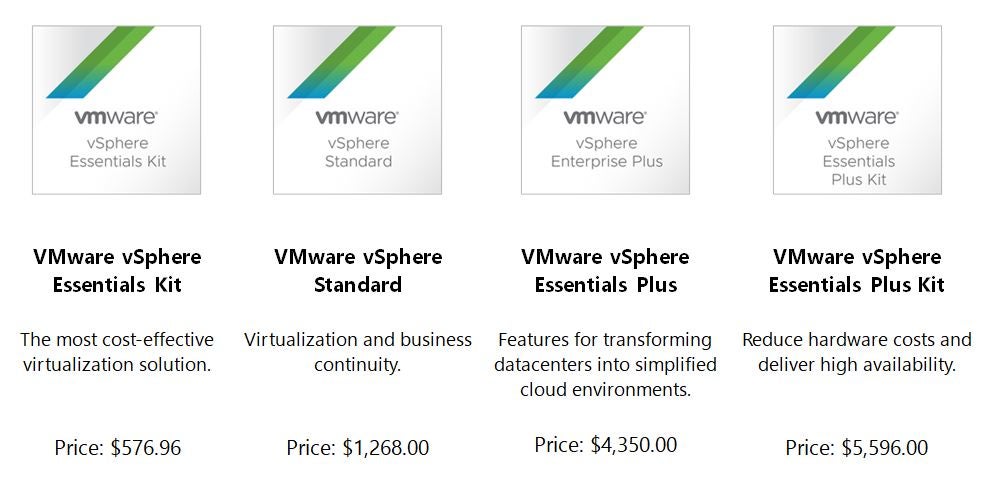

![]() VMware vSphere is VMware’s virtualization platform, and vCenter and ESXi are both important components of vSphere. VMware vSphere, vCenter, and ESXi were initialized as different technologies for different purposes, but now they’re combined into the vSphere platform. In this article, we discuss vSphere, vCenter Server, ESXi, and the differences between them.
VMware vSphere is VMware’s virtualization platform, and vCenter and ESXi are both important components of vSphere. VMware vSphere, vCenter, and ESXi were initialized as different technologies for different purposes, but now they’re combined into the vSphere platform. In this article, we discuss vSphere, vCenter Server, ESXi, and the differences between them.
Read more: VirtualBox vs VMware: Choosing the Best Virtualization Tool
vSphere is a cloud computing virtualization platform delivered by VMware. VMware vSphere is not a particular software, but rather a software package that has several sub-components.
vSphere encompasses several individual products and technologies to provide a complete infrastructure for virtualization. vSphere includes an updated version of vCenter Configuration Manager and Application Discovery Manager, as well as vMotion to move multiple virtual machines (VMs) at a time from one host server to another.
VMware vSphere is a software suite of virtualization solutions that has many software components such as vCenter, ESXi, vSphere client, and others. Purportedly, VMware vSphere 7, the latest release, combines with VMware Tanzu to enable IT administrators to get started with Kubernetes workloads within an hour.
Read more: VMware vSphere 7 Security & Features
vCenter Server is advanced server management software provided by VMware. vCenter Server provides a centralized platform for controlling vSphere environments, providing visibility across hybrid clouds. It allows the automation and delivery of virtual infrastructure.
VMware vCenter Server is a centralized management application that allows managing virtual machines and ESXi hosts. It is a necessary application for the users of VMware enterprise features like vMotion, VMware Update Manager, VMware High Availability, and others.
VMware ESXi is an enterprise-class native hypervisor (type-1). ESXi is not just a software application; it also integrates vital operating system components. ESXi was previously known as ESX (Elastic Sky X). The replacement for ESX was internally called VMvisor, but later changed to ESXi, with the “i” standing for “integrated.”
VMware ESXi effectively partitions hardware to consolidate applications and reduce costs. It is an industry leader for efficient architecture, setting the standard for reliability, performance, and support when deploying and serving virtual computers. Customers can use ESXi with the free vSphere Hypervisor edition, or as part of a paid vSphere edition.
Read more: Proxmox vs ESXi: Choosing the Best Hypervisor
VMware vSphere, vCenter Server, and ESXi are the necessary parts to build VMware infrastructure. It is clear that vSphere, vCenter, and ESXi are related to each other, but they are different.
It is important to know the differences between vSphere, vCenter Server, and ESXi for a clear understanding of where and when each fits into the mix of VMware virtualization solutions.
| vSphere | vCenter | ESXi | |
|---|---|---|---|
| What it is | Virtualization platform delivered by VMware | Advanced server management software installed on a host machine (physical or virtual) | Virtualization software (Hypervisor) installed on a physical machine |
| What it provides | A complete infrastructure for virtualization | A centralized and extensible platform | Virtualization layer |
| What it's for | Modern applications using any combination of VMs, containers, and Kubernetes | Controlling VMware vSphere environments | Deploying and serving VMs |
| Allows IT teams to | Build a reliable and resilient infrastructure | Automate and deliver a virtual infrastructure across the hybrid cloud | Create and manage multiple VMs |
| Initial release | April 21, 2009 | December 5, 2003 | March 23, 2001 |
vSphere, vCenter, and ESXi were initialized at different times to provide different services for virtualizations, and then combined into a larger software suite. As such, VMware vSphere and its components deliver a more reliable and cost-effective solution.
“With rapid provisioning of servers through virtualization, we can now scale horizontally to handle those bursts, and we’ve been able to successfully handle surges,” says Bipin Jayaraj, CIO for Make-A-Wish America, which uses vSphere.
VMware vSphere offers several pricing models based on user requirements:

Read next: Proxmox vs VMware Comparison


Al Mahmud Al Mamun is a technologist, researcher, and writer for TechnologyAdvice. He has a strong knowledge and background in Information Technology (IT) and Artificial Intelligence (AI). He worked as an Editor-in-Chief at a reputed international professional research Magazine. Although his Bachelor's and Master's in Computer Science and Engineering, he also attained thirty online diploma courses and a hundred certificate courses in several areas.
Property of TechnologyAdvice. © 2025 TechnologyAdvice. All Rights Reserved
Advertiser Disclosure: Some of the products that appear on this site are from companies from which TechnologyAdvice receives compensation. This compensation may impact how and where products appear on this site including, for example, the order in which they appear. TechnologyAdvice does not include all companies or all types of products available in the marketplace.